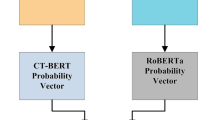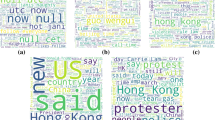Abstract
Online news and information sources are convenient and accessible ways to learn about current issues. For instance, more than 300 million people engage with posts on Twitter globally, which provides the possibility to disseminate misleading information. There are numerous cases where violent crimes have been committed due to fake news. This research presents the CovidMis20 dataset (COVID-19 Misinformation 2020 dataset), which consists of 1,375,592 tweets collected from February to July 2020. CovidMis20 can be automatically updated to fetch the latest news and is publicly available at: https://github.com/everythingguy/CovidMis20.
This research was conducted using Bi-LSTM deep learning and an ensemble CNN+Bi-GRU for fake news detection. The results showed that, with testing accuracy of 92.23% and 90.56%, respectively, the ensemble CNN+Bi-GRU model consistently provided higher accuracy than the Bi-LSTM model.
Access this chapter
Tax calculation will be finalised at checkout
Purchases are for personal use only
Similar content being viewed by others
References
Pennycook, G., Rand, D.G.: The psychology of fake news. Trends Cogn. Sci. 25(5), 388–402 (2021)
Chung, J., Gulcehre, C., Cho, K., Bengio, Y.: Empirical evaluation of gated recurrent neural networks on sequence modeling. arXiv preprint arXiv:1412.3555 (2014)
Hassan, R., Islam, M.R.: A supervised machine learning approach to detect fake online reviews. In: 2020 23rd International Conference on Computer and Information Technology (ICCIT), pp. 1–6. IEEE (2020)
Reddy, P.B.P., Reddy, M.P.K., Reddy, G.V.M., Mehata, K.M.: Fake data analysis and detection using ensembled hybrid algorithm. In: 2019 3rd International Conference on Computing Methodologies and Communication (ICCMC), pp. 890–897. IEEE (2019)
Patwa, P., et al.: Fighting an infodemic: Covid-19 fake news dataset. In: Chakraborty, T., Shu, K., Bernard, H.R., Liu, H., Akhtar, M.S. (eds.) CONSTRAINT 2021. Communications in Computer and Information Science, vol. 1402, pp. 21–29. Springer, Cham (2021). https://doi.org/10.1007/978-3-030-73696-5_3
Al Asaad, B., Erascu, M.: A tool for fake news detection. In: 2018 20th International Symposium on Symbolic and Numeric Algorithms for Scientific Computing (SYNASC), pp. 379–386. IEEE (2018)
Yu, Z., He, L., Luo, W., Tse, R., Pau, G.: Deep learning for COVID-19 prediction based on blood test. In: IoTBDS, pp. 103–111 (2021)
Aslam, N., Khan, I.U., Alotaibi, F.S., Aldaej, L.A., Aldubaikil, A.K.: Fake detect: a deep learning ensemble model for fake news detection. Complexity 2021 (2021)
Tashtoush, Y., Alrababah, B., Darwish, O., Maabreh, M., Alsaedi, N.: A deep learning framework for detection of COVID-19 fake news on social media platforms. Data 7(5), 65 (2022)
What is Natural Language Processing and How Does It Work. https://monkeylearn.com/blog/what-is-natural-language-processing/. Accessed 10 Sept 2021
Natural Language Toolkit. https://www.nltk.org/. Accessed 2 Sept 2021
Keras: the Python deep learning API. https://keras.io/. Accessed 2 Sept 2021
Sklearn.preprocessing.OneHotEncoder. https://scikit-learn.org/stable/modules/generated/sklearn.preprocessing.OneHotEncoder.html. Accessed 2 Sept 2021
Kowsari, K., Heidarysafa, M., Brown, D.E., Meimandi, K.J., Barnes, L.E.: RMDL: random multimodel deep learning for classification. In: Proceedings of the 2nd International Conference on Information System and Data Mining, pp. 19–28 (2018)
Sherstinsky, A.: Fundamentals of recurrent neural network (RNN) and long short-term memory (LSTM) network. Phys. D 404, 132306 (2020)
Media Bias Fact Check (MBFC). https://mediabiasfactcheck.com/. Accessed February 2021
Acknowledgments
This work was supported in part by Saginaw Valley State University and the National Science Foundation under Grant OAC-2017289, National Institute of Health under Grant 1R15GM120820-01A1, and WMU FRACAA 2012-22.
Author information
Authors and Affiliations
Corresponding author
Editor information
Editors and Affiliations
Rights and permissions
Copyright information
© 2023 The Author(s), under exclusive license to Springer Nature Switzerland AG
About this paper
Cite this paper
Mulahuwaish, A., Osti, M., Gyorick, K., Maabreh, M., Gupta, A., Qolomany, B. (2023). CovidMis20: COVID-19 Misinformation Detection System on Twitter Tweets Using Deep Learning Models. In: Zaynidinov, H., Singh, M., Tiwary, U.S., Singh, D. (eds) Intelligent Human Computer Interaction. IHCI 2022. Lecture Notes in Computer Science, vol 13741. Springer, Cham. https://doi.org/10.1007/978-3-031-27199-1_47
Download citation
DOI: https://doi.org/10.1007/978-3-031-27199-1_47
Published:
Publisher Name: Springer, Cham
Print ISBN: 978-3-031-27198-4
Online ISBN: 978-3-031-27199-1
eBook Packages: Computer ScienceComputer Science (R0)




